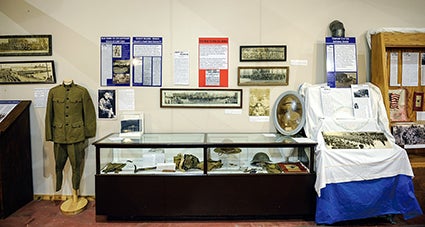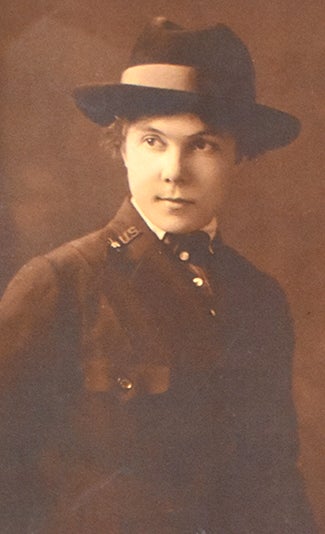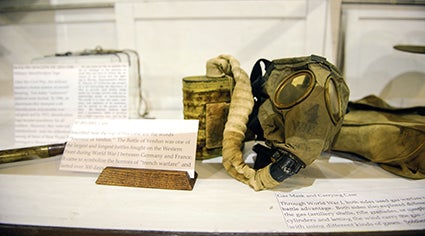World War I comes to life in new display
Published 9:02 am Monday, August 7, 2017

- A portrait of Leslie Hildreth stares out from the display at the Mower County HIstorical Society. Photos by Eric Johnson/photodesk@austindailyherald.com
“Mower County is now bound by flesh and blood ties that make the heart of every citizens throb with a new and intense patriotism. Our boys are in the struggle and our hearts and souls are with them.” — Mower County Transcript-Republican, September 1917
When World War I was declared in the U.S. on April 6, 1917, the date, one Austin newspaper editor recalled later, would “glow upon the pages of history.”
Some of those pages make up a featured exhibit at the Mower County Historical Society, entitled, “Headlines of War,” featuring articles from the Mower County Transcript-Republican, a semi-weekly newspaper published in Austin. The display will be featured during the Mower County Fair, which begins Tuesday.
The display recognizes the 100th anniversary of the U.S. entry into the war as seen through the eyes of its Mower County citizens, emphasizing the early months of 1917.
Curator Jaimie Timm chose the newspaper to tell the story, because there was a unique, local voice that gave the history-making event a special perspective.

The Mower County Historical Society’s World War I display is up and ready, just in time of the Mower County Fair.
“The local newspapers were the main source of news for the community; I really enjoyed looking for that different point of view,” Timm said.
Although many Americans favored an isolationist philosophy in the early years of the war that began in 1914, the sinking of several American merchant ships earlier in 1917 — as well as the sinking of the British ocean liner RMS Lusitania by Germans, that took over 100 American lives in 1915 —turned the tide toward involvement.
After the U.S. joined the conflict, Austin immediately got to work in support of the war effort, starting what it felt was most important: The publishing of rules for the display of the flag.
History tells us that a flurry of proclamations by Mayor John Anderson followed, including those that made sure no strip of land went uncultivated, in preparation for a food shortage; any amateur with a “wireless apparatus” had to have it dismantled; and if you were a German alien, you had to give up fire arms.
At a Loyalty Day meeting at Dexter, a St. Paul pastor gave an address, urging “all to be fair and to keep our minds free from the spirit of hate. We are at war with the political philosophy of Germany. We are not at war with her farmers, her artisans, her artists … God forbid that out of this war should come the heritage of hate.”

Marie Rettig served in World War I as a U.S. Army nurse after graduating from Lankenau Hospital’s nurse training program in Philadelphia in 1917.
Photo courtesy of the Mower County Historical Society
Austin finally joined the effort in May 1917, when its National Guard Unit, Company G of the Second Minnesota Infantry, based in Austin, was mobilized upon federal order.
The Transcript-Republican urged its young men to sign up and wasn’t above some editorializing.
Capt. A. C. Page of Company G — he was also Austin’s former mayor — received instructions to get medical exams underway in July. It was expected that the company would head for France by Oct. 1.
“You young men between 21 and 31 years should not wait another day for the wheel of fortune to decided whether or not you are to serve the colors for Uncle Sam. There is yet time for you to report at the Austin Armory and arrange for an examination,” the Transcript urged.
“If you are the only boy or red blooded fighting man at home and your people are absolutely dependent on you for (their) keep, physically and financially, your place is at home by all means; but if on the other hand your parents have the means to hire a man to take your place or you have one or more brothers simply get together and decide at once and not next year that you are going to do your duty and become a volunteer member of Company G …”
And, after the doctors arrived, it was found that 12 volunteers failed to pass the physical exams. The Transcript-Republican wasted no time imploring more to step forward:
“We want and must have before Friday night of this week 12, good red-blooded patriotic men who will serve Company G, Capt. Page and Uncle Sam. Will you be one of the twelve? If so, report at the Armory at once and arrange for physical examination … Look at the company roster. You may find a tent mate you care to bunk with. We need you and in a few days it may be too late for you to select the company you care to soldier with.
“Come over to the Armory at once, boys, we want you NOW.”

A gas mask from World War I is on display at the Mower County Historical Society.
The first Mower County casualty came before Company G left town; Private J. C. Malone of Austin, who served with the Canadian infantry stationed in France, died in August 1917. His death was the first of 64 who died from Mower County. Thirteen were to die in action; the rest were from accidents or disease, including the deadly Spanish flu pandemic that began its scourge in early 1918. Olaf Damm, whose name is carried on the local American Legion post, was the first Mower County man to die fighting with U.S. troops.
Malone’s body was buried in “No Man’s Land,” his family learned later. In a letter from the Canadian government, his family was told that “the heavy loss which you and the Nation have sustained would indeed be depressing were it not redeemed by the knowledge that the brave comrade for whom we mourn performed his duties fearlessly and … gave his life for the great cause of Human Liberty and the Defence of the Empire.”
In September, Company G and the community’s Home Guards left to train at Fort Dodge, and then to Camp Cody in New Mexico. They then headed to Camp Dix in New Jersey before traveling to Scotland, and then, LeHavre, France.
The Transcript-Republican had a simple lead to its story: “Mower county is now a part of the great world war.”
“Thousands had gathered at the depot and all available space was filled. Box cars, sheds and every available vantage point was crowded with those eager to secure a good view. It was a sad sight as the relatives and friends said good bye and hundreds shed tears of sympathy with them.
“The departure … has awakened as never before the realization that we are really at war.”




